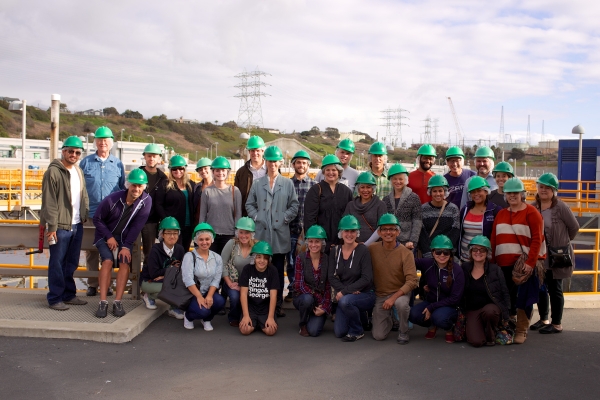9 Cool Facts About the Hyperion Plant
Heal the Bay chief Ruskin Hartley says sewage isn’t sexy, but it’s fascinating:
I recently had the chance to tour the Hyperion treatment plant with a group of staff and volunteers from Heal the Bay. Many thanks to our friends at the Bureau of Sanitation for organizing an instructive tour. Here’ some of what I learned:
1. Hyperion was one of the 12 Greek Titans and the father of the god Helius. Hyperion is also the name of a sewage treatment plant in L.A. It’s also the name of the world’s tallest tree — a 379-foot coast redwood in Redwood National Park.
2. Hyperion is the largest sewage plant, by volume, west of the Mississippi. It treats 300 million gallons a day (MGD) on a regular basis and can handle 900 MGD flat out. By comparison, you’d only need 100 MGD to fill the Rose Bowl. Or 90,000 fans. Take your pick.
3. You may have heard of effluent. It’s the treated wastewater discharged into a bay or ocean. But did you know that influent is the name for what they call the raw sewage that flows in the front door of the plant. I didn’t.
4. The city of L.A. purchased the land that Hyperion stands on in 1892 and built the first modern plant in 1949. Up until that time, raw sewage was discharged to the Bay. But I use the word modern loosely. From 1949-98, the plant blended treated and untreated effluent and then pumped it into the Bay. The result? Sick surfers, dead fish, and dolphins with skin lesions. Oh, and a fight with Heal the Bay.
5. Heal the Bay was founded in 1985 to get Hyperion to clean up its act. By 1987 officials had agreed to fix the problem. But it took 12 years and $1.6 billion to get to a place where only treated effluent was pumped into the Bay. Now surfers are healthier, dolphins are happier, and the fish die of natural causes. Unless it’s raining. But urban runoff is another story and a much more challenging problem we work on day in day out.
6. Despite the fact the new plant has allowed the Bay to recover, the treated effluent itself is not safe for humans. Seagulls may swim in the treated water ponds, but if you or I did the same we would get sick. So the last piece of the treatment puzzle is the dilution provided by the Santa Monica Bay. It does it tirelessly and doesn’t get paid.
7. It can take several days for influent to get from your toilet to Hyperion. But once there, the liquid is processed within a day. The solids take longer to be digested by beneficial bacteria and converted to compost that is used in Kern County farms and Griffith Park.
8. Some 6,700 miles of sewage line feed into Hyperion. That’s like L.A. to N.Y. and back.
9. About 80% of the power needs for Hyperion are met from methane gas generated on-site from all that poop.
 Heal the Bay staff is all smiles after a tour of the Hyperion plant, the historic Ground Zero for the group.
Heal the Bay staff is all smiles after a tour of the Hyperion plant, the historic Ground Zero for the group.



